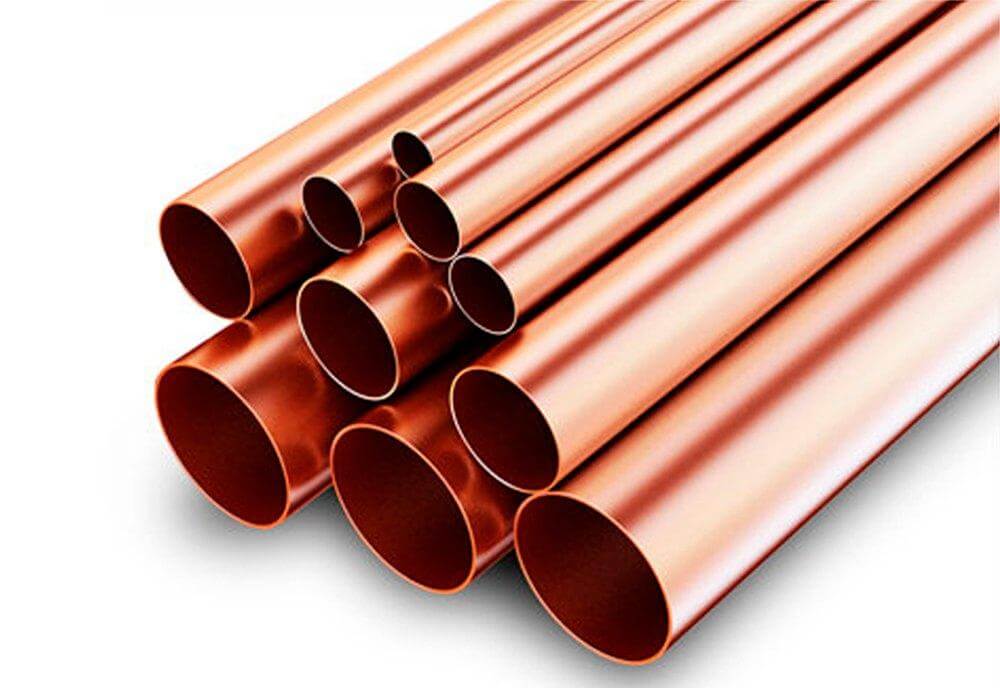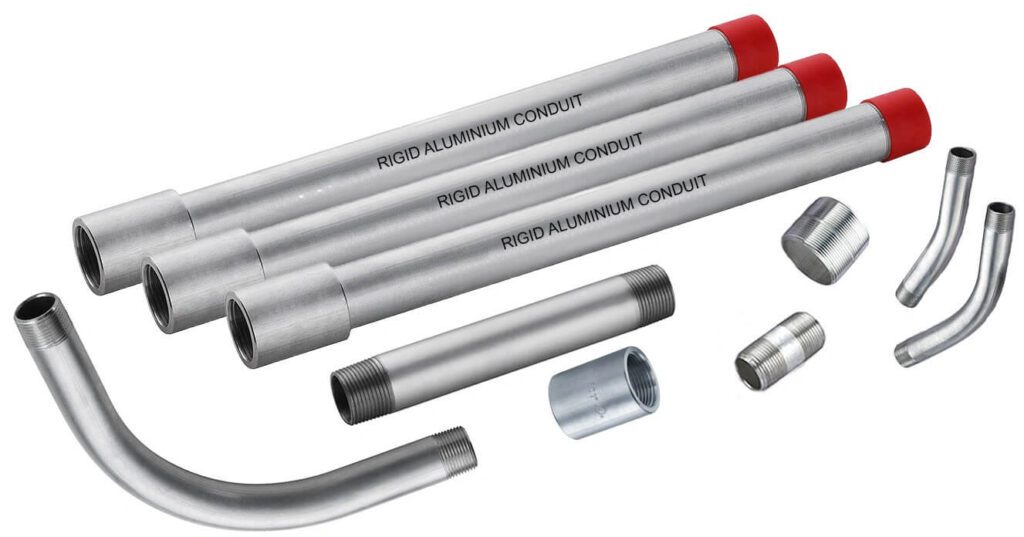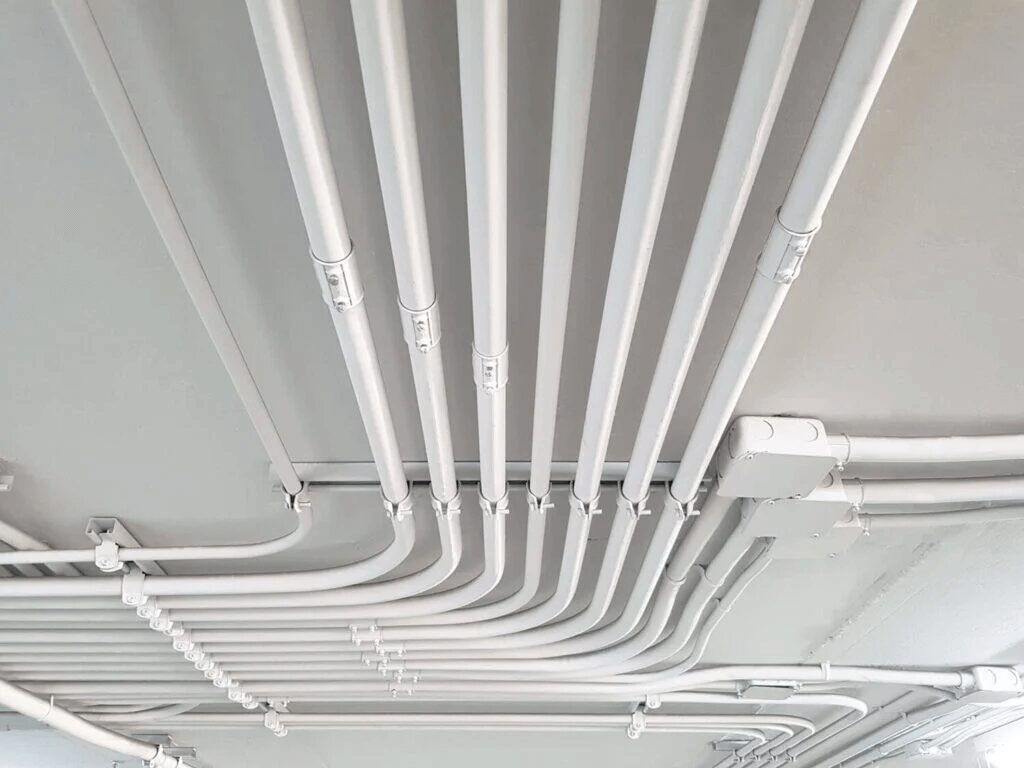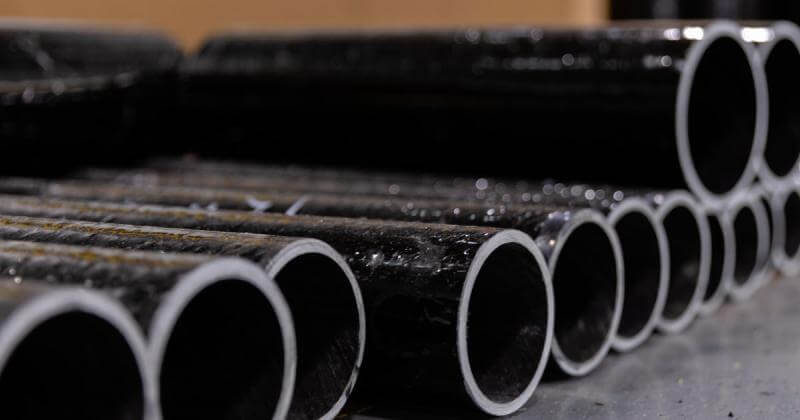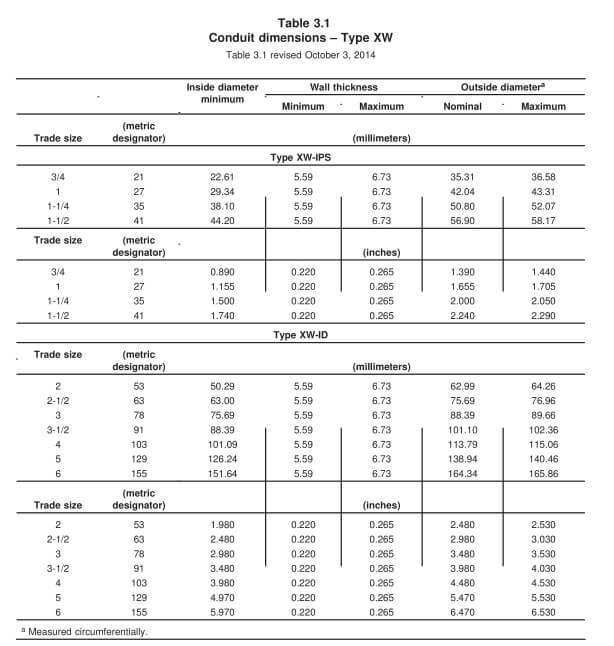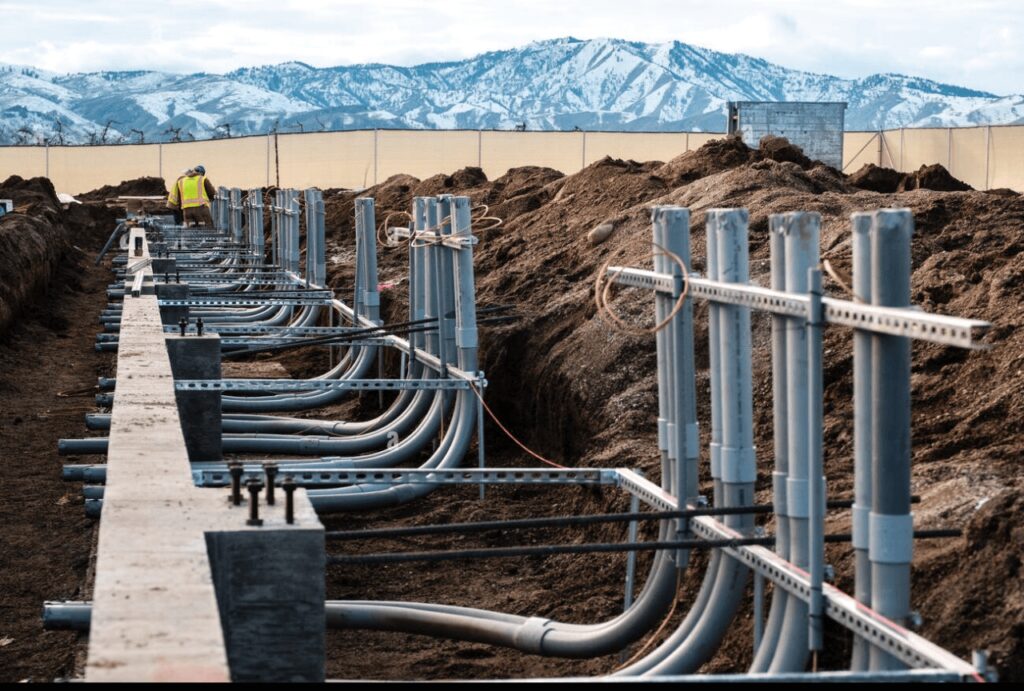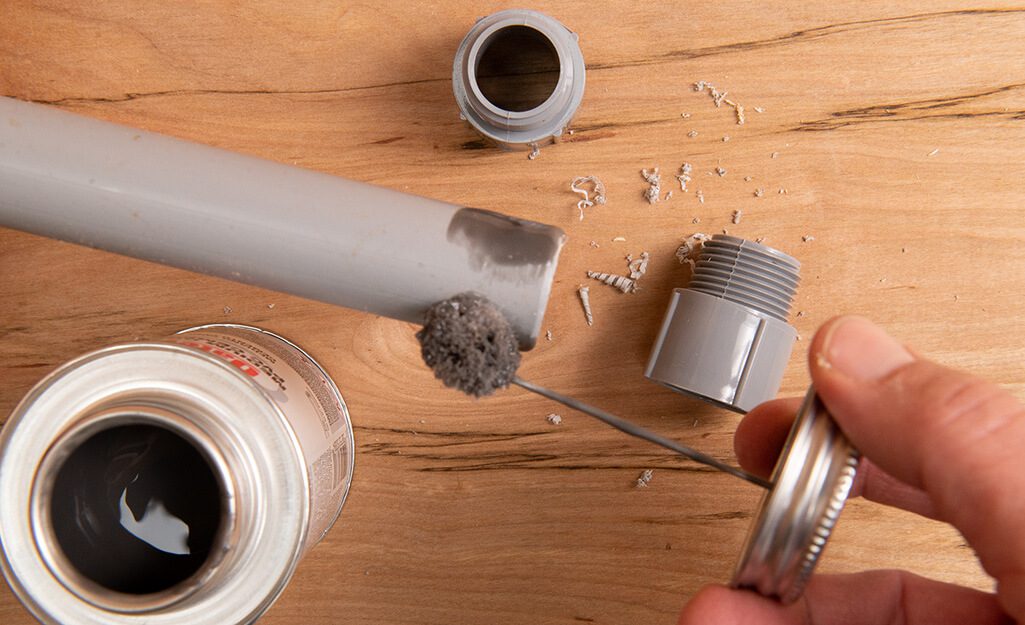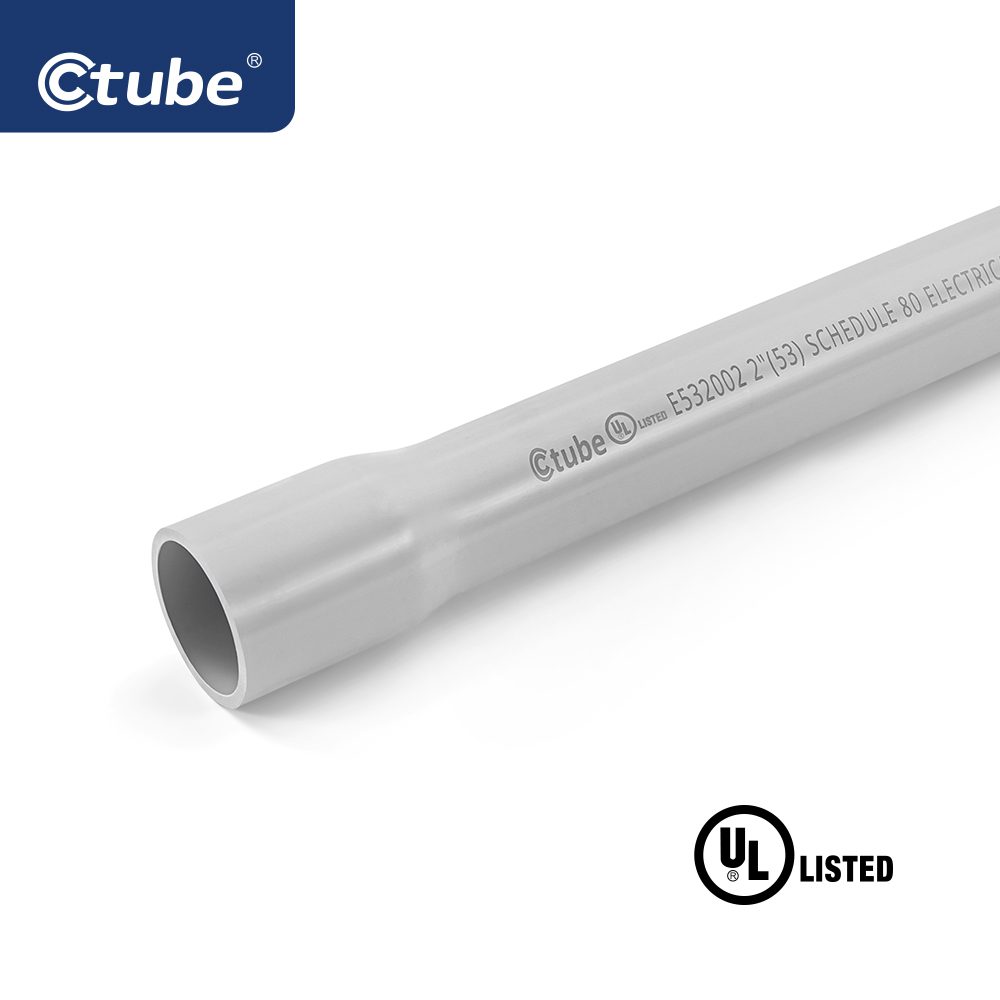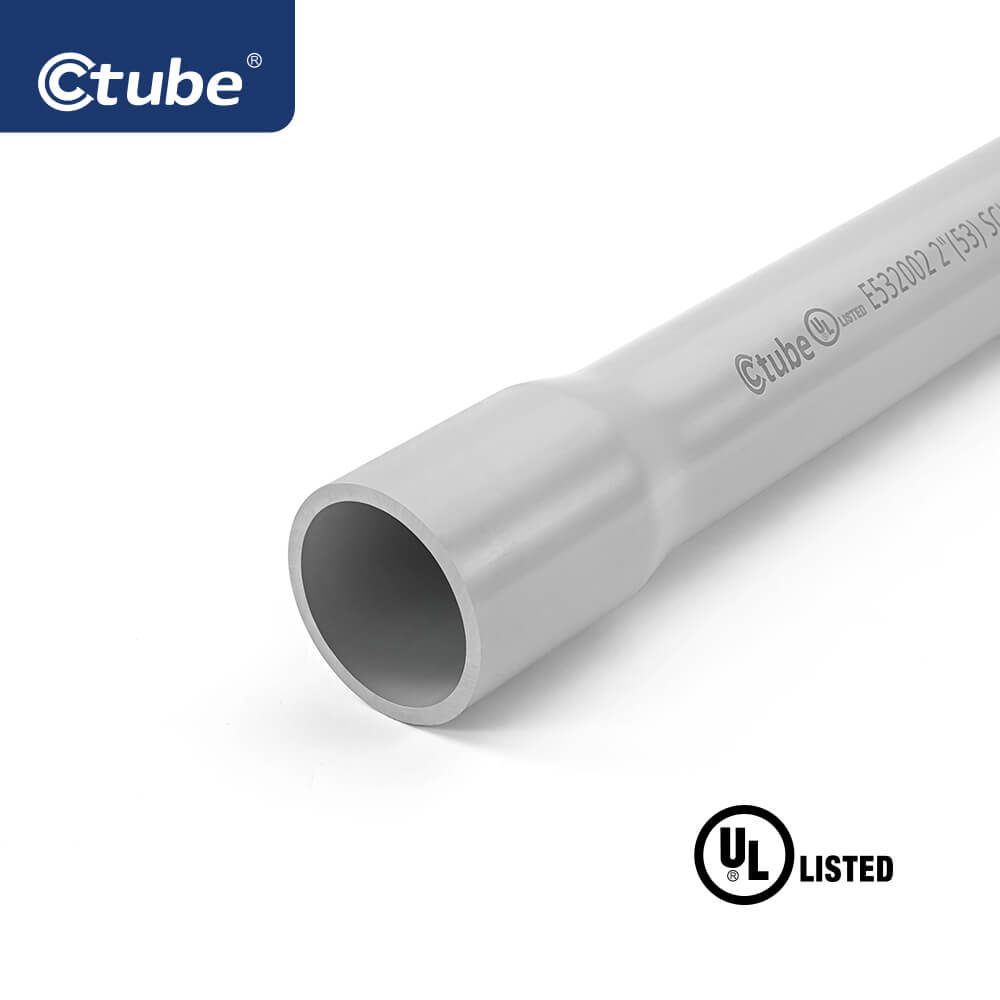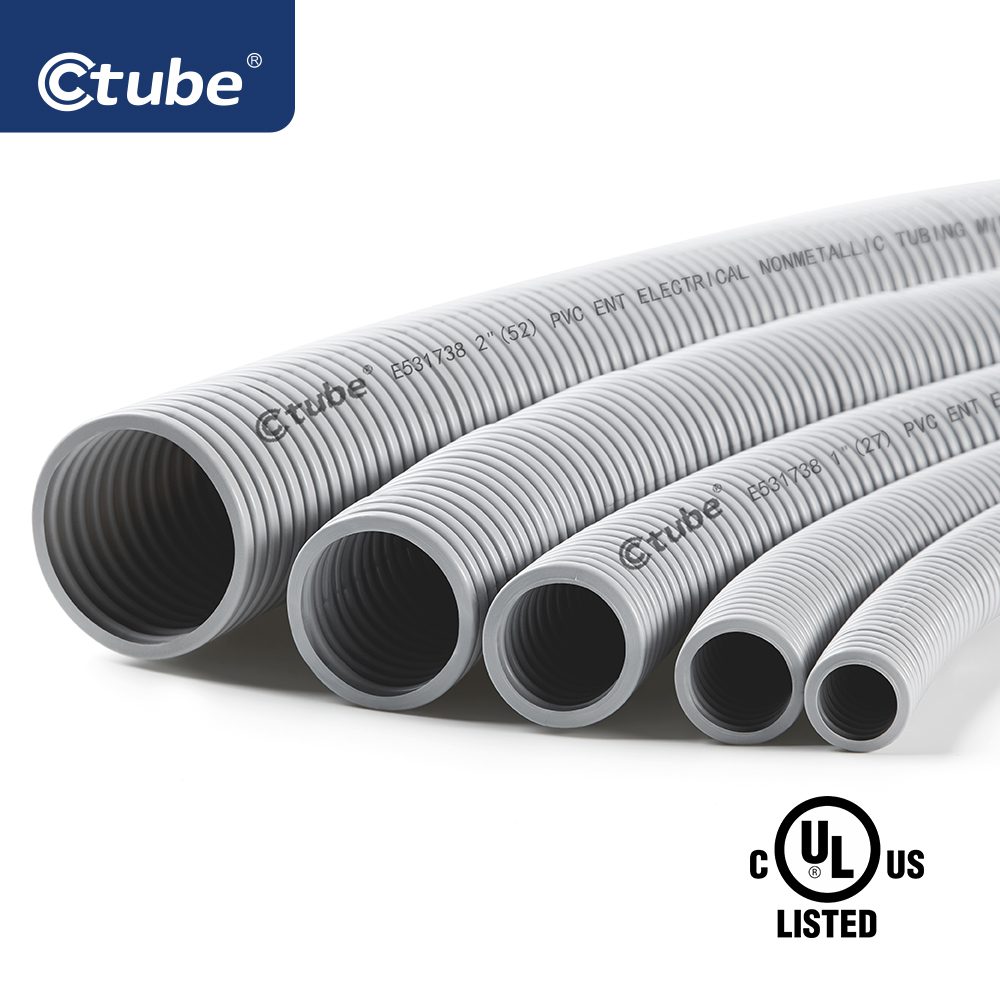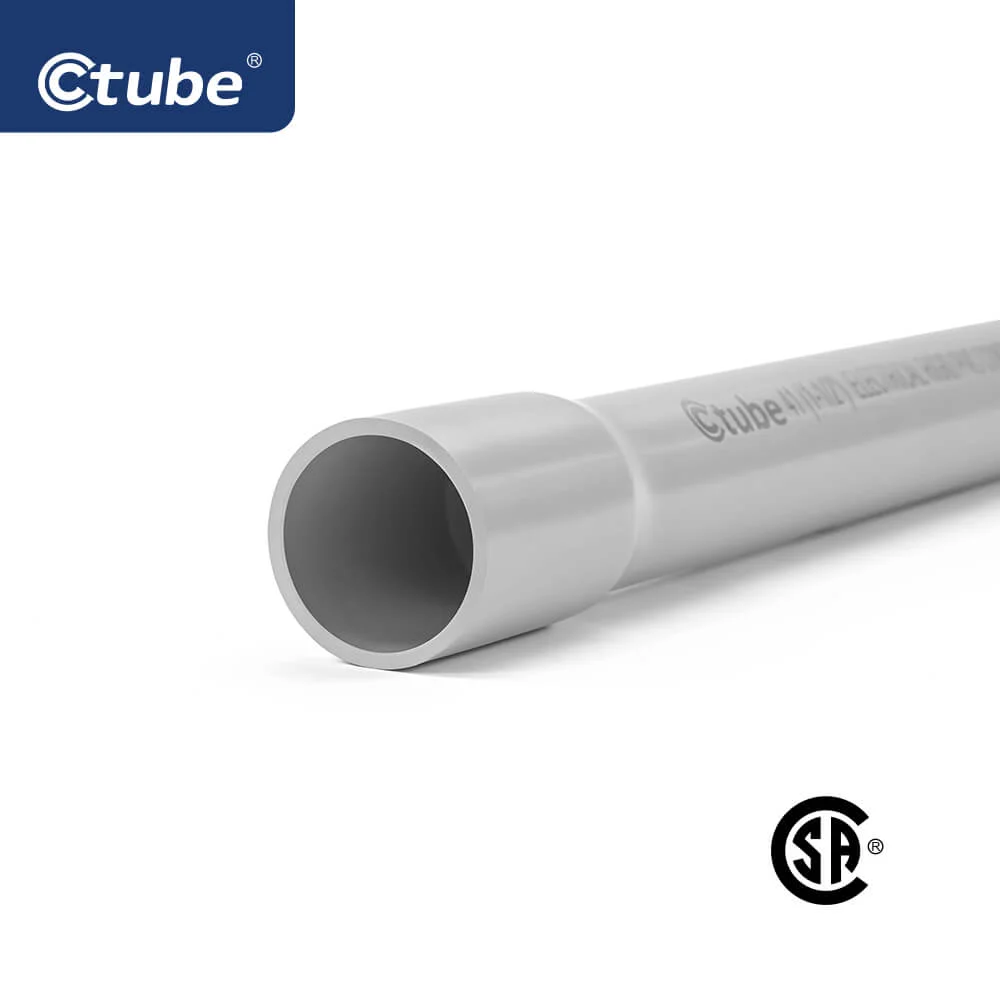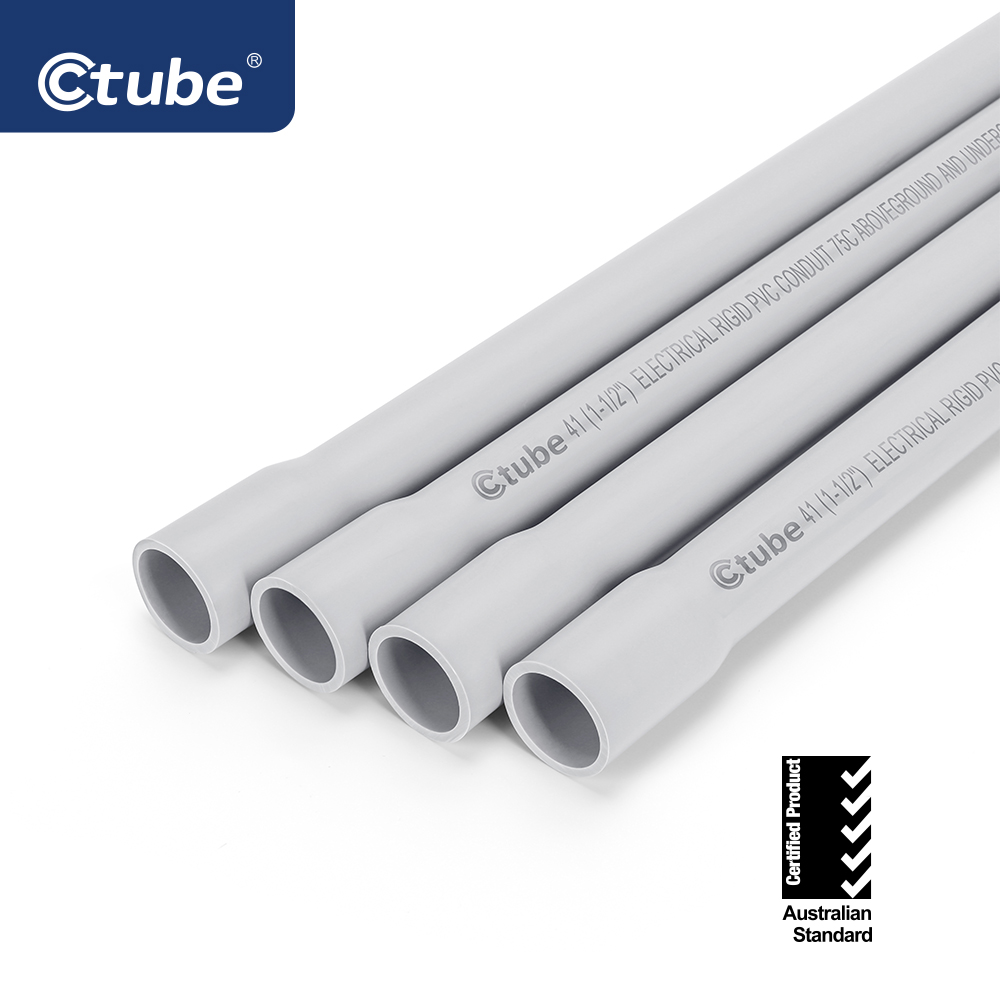Table des matières
Basculer1. Introduction : comprendre les conduits électriques rigides
In the realm of electrical systems, conduits play a pivotal role in ensuring safety, longevity, and functionality.
Electrical conduits serve as protective channels through which electrical wiring is run, shielding cables from physical damage, moisture, chemicals, and other environmental factors.
Among the various types of conduits available, rigid electrical conduit stands out for its robustness and suitability in both industrial and residential applications.
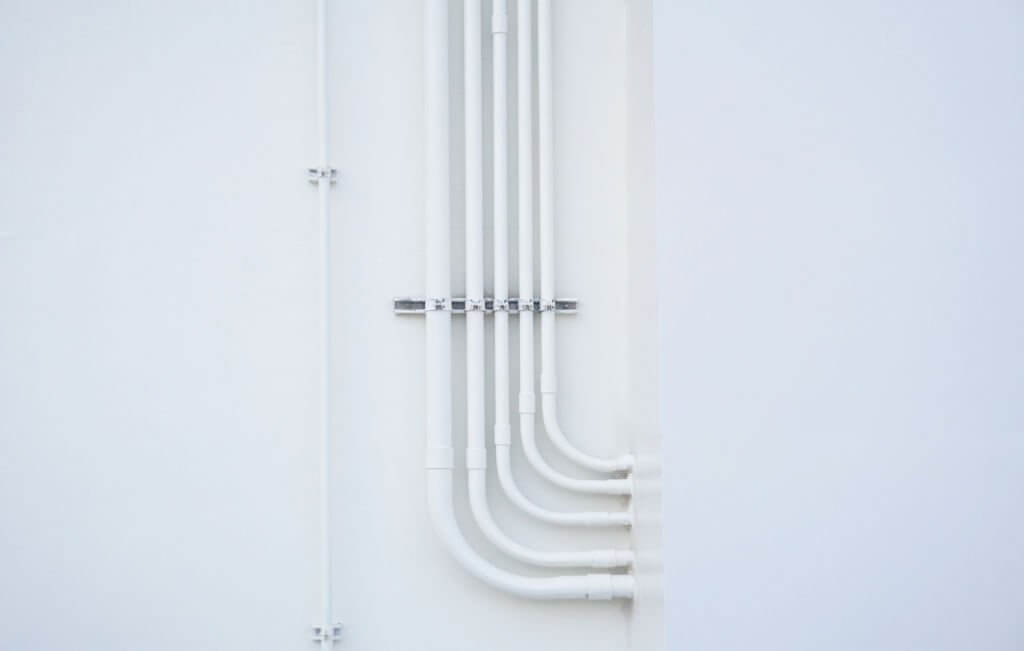
Rigid electrical conduit is available in a variety of forms, each designed to serve specific needs depending on the material and application.The primary materials used for rigid electrical conduits include PVC (Polyvinyl Chloride), galvanized steel, aluminum, and RTRC (Reinforced Thermosetting Resin Conduit), among others.Each material brings unique advantages, making rigid conduit versatile across a range of environments and project requirements.By the end of this post, you will have a thorough understanding of what rigid electrical conduit is, why it is an essential component in modern electrical systems, and how to incorporate it into your next project to maximize safety, efficiency, and compliance.
Metal Rigid Conduit includes types like Rigid Metal Conduit (RMC), Intermediate Metal Conduit (IMC), and Electrical Metallic Tubing (EMT), known for their strength and durability, making them suitable for industrial and outdoor use.Plastic Rigid Conduit, such as Rigid Polyvinyl Chloride (PVC), is lightweight, corrosion-resistant, and commonly used in environments where moisture protection is essential, like underground installations.
Additionally, RTRC conduit, made from fiberglass, offers excellent electrical insulation, thermal resistance, and corrosion protection, making it an ideal choice for applications requiring non-conductive and high-strength materials.
Dans l’article suivant, nous présenterons les détails des conduits rigides fabriqués à partir de différents matériaux.
2. Types of Rigid Electrical Conduits – Detailed Introduction
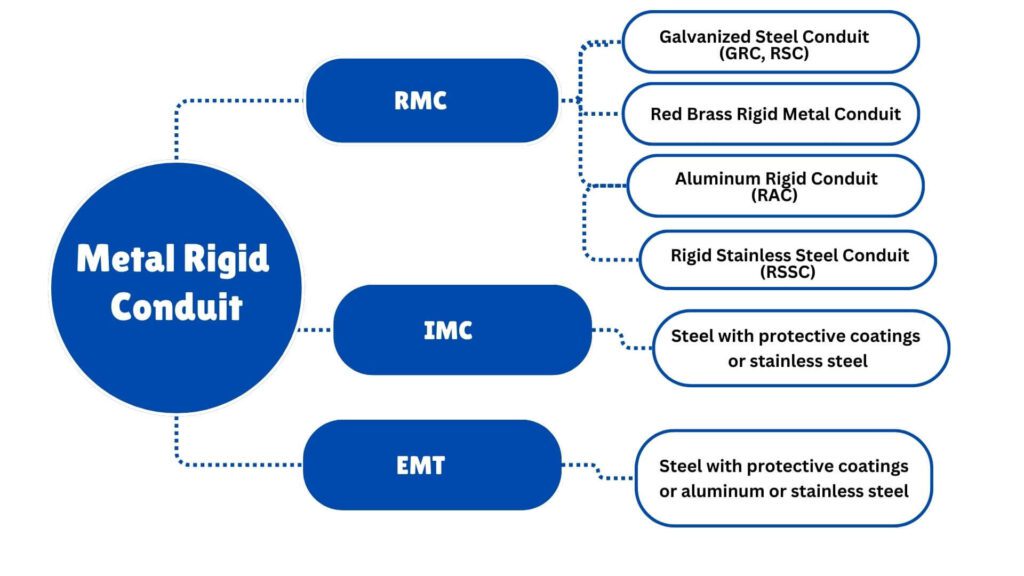
RMC est disponible dans les matériaux suivants :
• Steel with protective coatings
• Aluminum
• Red brass
• Stainless steel
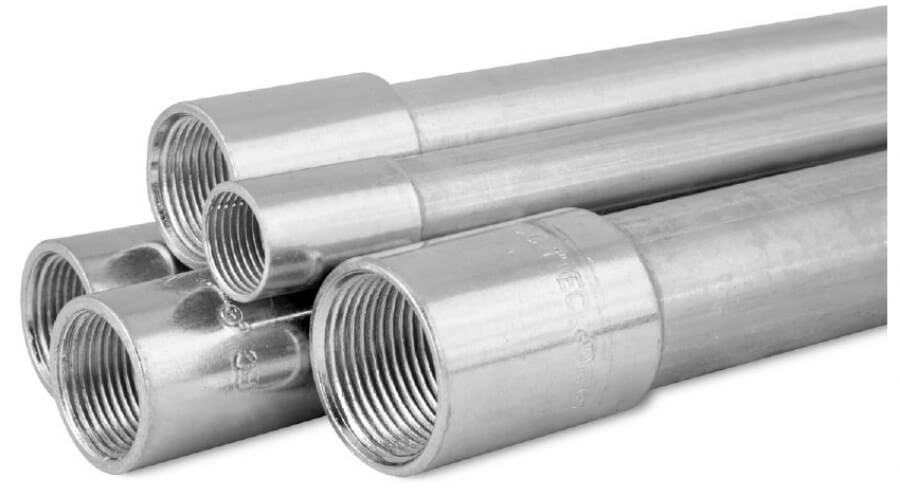
Material and Structure
Each tube used for Rigid Steel Conduit (RSC) shall be made of steel, ensuring that it is straight and features a circular cross-section.
| Metric Designator | Outside Diameter (mm) | Trade Size | Outside Diameter, a (in) |
|---|---|---|---|
| 12b | 17.15 | 3/8b | 0.675 |
| 16 | 21.34 | 1/2 | 0.840 |
| 21 | 26.67 | 3/4 | 1.050 |
| 27 | 33.40 | 1 | 1.315 |
| 35 | 42.16 | 1-1/4 | 1.660 |
| 41 | 48.26 | 1-1/2 | 1.900 |
| 53 | 60.33 | 2 | 2.375 |
| 63 | 73.03 | 2-1/2 | 2.875 |
| 78 | 88.90 | 3 | 3.500 |
| 91 | 101.60 | 3-1/2 | 4.000 |
| 103 | 114.30 | 4 | 4.500 |
| 129 | 141.30 | 5 | 5.563 |
| 155 | 168.28 | 6 | 6.625 |
a Tolerances: Trade Size 12–41 (3/8–1-1/2) ± 0.38 mm (±0.015 in). Trade Size 53–155 (2–6) ± 1%.
b In the United States, 12 (3/8) trade size is permitted for special applications. In Canada, 12 (3/8) trade size is not permitted according to the Canadian Electrical Code, Part I.
Welded Seams
The welding process for RMC tubes must meet strict criteria to ensure safety and functionality.
Welded seams should not have metal trimmings, sharp edges, or projections that could interfere with the internal wiring or the installation process.
A slight bead along the interior of the seam is permissible, as long as it is smooth and does not exceed 0.38 mm (0.015 in) in height for trade sizes 12 to 53 (3/8 inch to 2 inches) or 0.51 mm (0.020 in) for trade sizes 63 to 155 (2 ½ inches to 6 inches).
Standard Length and Weight Requirements
The standard length of straight zinc-coated conduit or bare threaded tubes to be coated with an alternate corrosion-resistant material, including one coupling, must follow the specifications detailed Table in the followinggs.
These tables outline the dimensions and weights for conduit that complies with the given standards.
| Metric Designator | Length of Straight Conduita (mm) |
Min. Acceptable Weight of 10 Lengths of Conduit with Ten Couplings, (kg) Finished Zinc Coated Conduitb |
Min. Acceptable Weight of 10 Lengths of Conduit with Ten Couplings, (kg) Bare Threaded Tubec |
Trade Size | Length of Straight Conduit Feet and Inchesa ±1/4 |
Min. Acceptable Weight of 10 Lengths of Conduit with Ten Couplings, (lbs) Finished Zinc Coated Conduitb |
Min. Acceptable Weight of 10 Lengths of Conduit with Ten Couplings, (lbs) Bare Threaded Tubec |
|---|---|---|---|---|---|---|---|
| 12d | 3035 | 23.4 | 22.6 | 3/8 | 9′–11 1/2″ | 51.5 | 48.6 |
| 16 | 3030 | 35.8 | 34.4 | 1/2 | 9′–11″ | 78.9 | 75.8 |
| 21 | 3030 | 47.6 | 45.5 | 3/4 | 9′–11″ | 104.9 | 100.3 |
| 27 | 3030 | 69.4 | 65.8 | 1 | 9′–11″ | 153.0 | 145.1 |
| 35 | 3025 | 91.2 | 87.8 | 1-1/4 | 9′–11″ | 201.0 | 193.5 |
| 41 | 3025 | 112.9 | 109.4 | 1-1/2 | 9′–11″ | 249.0 | 241.2 |
| 53 | 3035 | 150.4 | 144.3 | 2 | 9′–11 1/2″ | 331.6 | 318.1 |
| 63 | 3010 | 209.6 | 203.4 | 2-1/2 | 9′–10 1/4″ | 462.0 | 448.4 |
| 78 | 3010 | 239.0 | 233.4 | 3 | 9′–10 1/4″ | 527.0 | 514.8 |
| 91 | 3010 | 274.1 | 268.4 | 3-1/2 | 9′–10 1/4″ | 604.4 | 591.5 |
| 103 | 2995 | 312.0 | 305.3 | 4 | 9′–10″ | 687.6 | 672.9 |
| 129 | 2995 | 591.7 | 578.6 | 5 | 9′–10″ | 1304.9 | 1275.6 |
| 155 | 2995 | 797.1 | 781.4 | 6 | 9′–10″ | 1757.0 | 1722.7 |
a The lengths indicated are designed to produce a 3.05 m (10 ft) length of conduit when a straight-tapped conduit coupling is attached.
b This conduit is protected with a zinc or zinc-based coating consisting primarily of zinc.
c This conduit is intended to be protected with an alternate corrosion-resistant coating.
d In the United States, 12 (3/8) trade size is permitted for special applications. In Canada, 12 (3/8) trade size is not permitted according to the Canadian Electrical Code, Part I.
Test Requirements
Essais de tubes de conduits rigides en acier
The tube testing process involves bending a sample of the smallest available trade size into a quarter circle around a mandrel, first at room temperature and then after conditioning it at 0°C (32°F) for 60 minutes.
The tube must not crack or break its weld. If the tube has a nonmetallic coating and is rated for temperatures below 0°C, the test is performed at that lower temperature.
| Coatings | Tests | Clause # |
|---|---|---|
| Zinc | Bend Test Cold Bend Zinc Coating Test |
6.2.1.1 6.2.1.3 6.2.2 |
| Alternate Corrosion-Resistant | Bend Test Cold Bend Ultraviolet Light and Water Salt Spray (Fog) Moist CO₂–SO₂–Air Tensile Adhesion Flame Propagation |
6.2.1.1 6.2.1.3 6.2.4.3 6.2.4.5 6.2.4.6 6.2.4.8 6.2.4.9 6.2.4.11 |
| Alternate Corrosion-Resistant Nonmetallic (in addition to the above) | Assembly, Bending, Resistance, Pull, and Fault Current Electrical Continuity Identification of Compounds Cold Impact |
5.3.3.2 5.3.5.2 6.2.1.5 6.2.1.0 |
| Organic | Bend Test Cold Bend Identification of Compounds Elasticity Warm Humid Air Test |
6.2.1.1 6.2.1.3 6.2.1.5 6.2.3.5 6.2.3.2 |
| Supplementary Coatings | Detrimental Effects to Primary Coating Fit of Couplings Electrical Continuity Flame Propagation |
5.3.5.2 5.3.5.2 5.3.5.2 6.2.4.11 |
| Surface Treatment | N/A if less than 0.038 mm (0.00015 in) thickness | 5.3.6.1 |
Essais de revêtement des conduits rigides en acier
The table in the following outlines different tests for various types of coatings applied to tubes, including zinc, alternate corrosion-resistant, nonmetallic, organic, and supplementary coatings.
These tests assess the coating’s performance under different conditions such as bending, exposure to UV light, salt spray, cold temperatures, and electrical continuity.
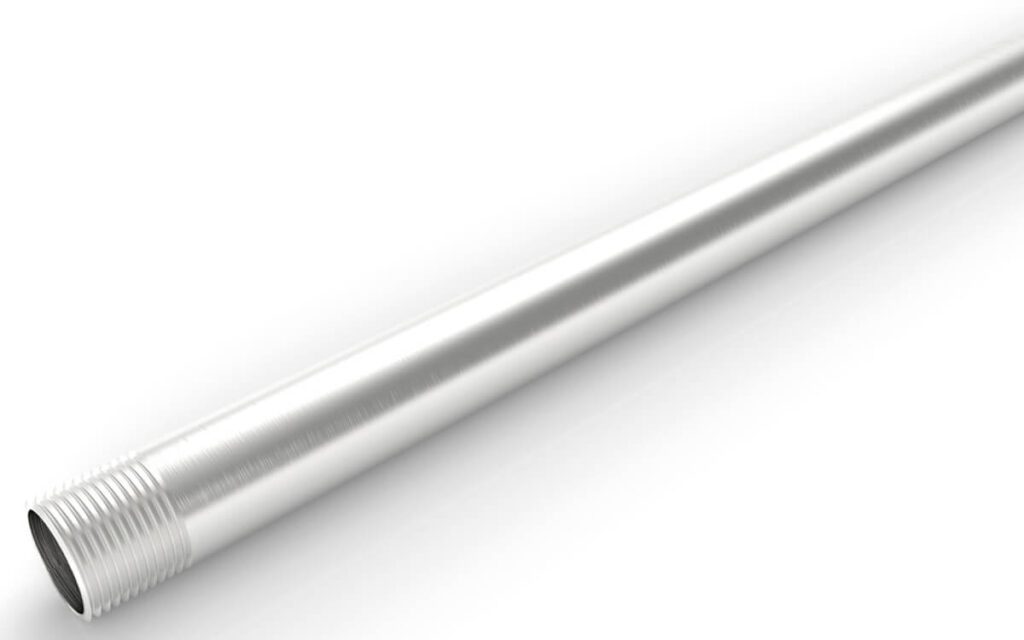
A threadable stainless steel raceway of circular cross-section designed for the physical protection and routing of wire conductors and use as an equipment grounding conductor when installed utilizing appropriate fittings.
Electrical Rigid Metal Conduit – Red Brass (ERMC-RB)
Electrical Rigid Metal Conduit – Aluminum (ERMC-A)
| Trade Size | Nominal Inside Diameter (in.) | Outside Diameter (in.) | Wall Thickness (in.) | Length w/o Coupling (ft & in.) | Min Weight (10 pcs with Couplings) (lb) |
|---|---|---|---|---|---|
| 1/2 | 0.632 | 0.840 | 0.104 | 9’11-1/4″ | 27.4 |
| 3/4 | 0.836 | 1.050 | 0.107 | 9’11-1/4″ | 36.4 |
| 1 | 1.063 | 1.315 | 0.126 | 9’11” | 50.7 |
| 1-1/4 | 1.394 | 1.660 | 0.138 | 9’11” | 66.2 |
| 1-1/2 | 1.624 | 1.900 | 0.138 | 9’11” | 86.2 |
| 2 | 2.067 | 2.375 | 0.154 | 9’10-1/2″ | 125.0 |
| 2-1/2 | 2.489 | 2.875 | 0.193 | 9’10-1/2″ | 182.5 |
| 3 | 3.068 | 3.500 | 0.225 | 9’10-1/4″ | 236.8 |
| 3-1/2 | 3.570 | 4.000 | 0.245 | 9’10-1/4″ | 358.7 |
| 4 | 4.032 | 4.500 | 0.265 | 9’10” | 454.9 |
| 5 | 5.073 | 5.563 | 0.245 | 9’10” | 454.9 |
| 6 | 6.093 | 6.625 | 0.266 | 9’10” | 604.4 |
| Trade Size | Outside Diameter (in.) Max |
Outside Diameter (in.) Min |
Wall Thickness (in.) Max |
Wall Thickness (in.) Min |
Nominal Inside Diameter (in.) | Length w/o Coupling (ft & in.) |
|---|---|---|---|---|---|---|
| 1/2 | 0.820 | 0.810 | 0.085 | 0.070 | 0.659 | 9’11-1/4″ |
| 3/4 | 1.034 | 1.024 | 0.090 | 0.075 | 0.863 | 9’11-1/4″ |
| 1 | 1.295 | 1.285 | 0.100 | 0.085 | 1.063 | 9’11” |
| 1-1/4 | 1.645 | 1.630 | 0.105 | 0.085 | 1.448 | 9’11” |
| 1-1/2 | 1.890 | 1.875 | 0.115 | 0.090 | 1.683 | 9’11” |
| 2 | 2.367 | 2.352 | 0.115 | 0.095 | 2.150 | 9’11” |
| 2-1/2 | 2.867 | 2.847 | 0.160 | 0.140 | 2.575 | 9’10-1/2″ |
| 3 | 3.486 | 3.466 | 0.160 | 0.140 | 3.176 | 9’10-1/2″ |
| 3-1/2 | 3.981 | 3.961 | 0.160 | 0.140 | 4.161 | 9’10-1/4″ |
| 4 | 4.476 | 4.456 | 0.160 | 0.140 | 4.166 | 9’10-1/4″ |
• Steel with protective coatings
• Aluminum
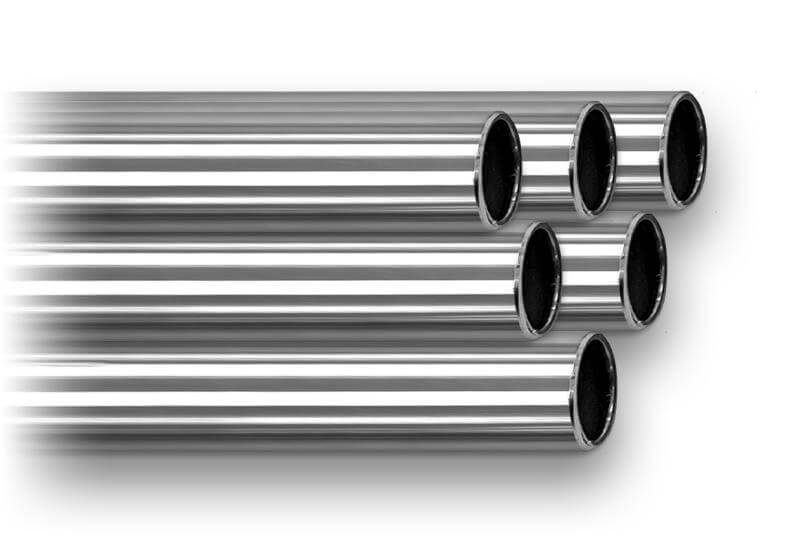
La surface intérieure doit être recouverte de zinc ou d'un revêtement organique. Ce revêtement intérieur doit conserver une surface lisse et continue, les variations mineures dues à un écoulement irrégulier du revêtement étant considérées comme acceptables.
| Trade Size | Metric Designator | Maximum Length (ft) | Maximum Length (m) |
|---|---|---|---|
| 1/2 – 3/4 | 16 – 21 | 10′ 1/4″ | 3.05 |
| 1 – 2 | 27 – 53 | 15′ 1/4″ | 4.58 |
| 2-1/2 – 4 | 63 – 103 | 20′ 1/4″ | 6.10 |
Article 342 Conduit métallique intermédiaire mentionnét IMC est disponible dans les matériaux suivants :
- Acier avec revêtements protecteurs
- Aluminium
| Trade Size | Metric Designator | External Diameter (in.) | Internal Diameter (in.) | Wall Thickness (in.) | Aluminum Min Weight (lb/ft) | Stainless Steel Min Weight (lb/ft) |
|---|---|---|---|---|---|---|
| 1/2 | 16 | 0.705 ±0.005 | 0.622 | 0.042 | 0.099 | 0.300 |
| 3/4 | 21 | 0.922 ±0.005 | 0.824 | 0.049 | 0.159 | 0.500 |
| 1 | 27 | 1.163 ±0.005 | 1.049 | 0.057 | 0.221 | 0.700 |
| 1-1/4 | 35 | 1.510 ±0.005 | 1.380 | 0.065 | 0.381 | 1.100 |
| 1-1/2 | 41 | 1.740 ±0.005 | 1.610 | 0.065 | 0.430 | 1.200 |
| 2 | 53 | 2.197 ±0.005 | 2.067 | 0.065 | 0.484 | 1.380 |
Test for Rigid PVC Conduit
Schedule 40 and Schedule 80 conduits have defined outside diameters and minimum wall thicknesses per trade size. These ensure structural integrity for various applications.
Conduit samples are tested using ASTM D 638. Aged samples must retain 95% of the tensile strength of unaged samples. Minimum strength is 5,000 psi for Schedule 40/80, and 4,000 psi for Type A and EB conduit.
Ten 6-inch conduit samples are tested using dropped weights. No more than three may crack or tear beyond 1/32 inch. Different weights are used: 20 lb for SCH 40, Type A, and EB; 75 lb for SCH 80.
Conduit must self-extinguish within 5 seconds after flame exposure and not ignite nearby materials. The test resembles the UL 94 V-0 rating, requiring high flame retardancy and no flaming drips.
Conduits must not deform or pull apart under pressure between steel plates. Flattened samples must maintain at least 70% of their original inside diameter.
Crush resistance measures a material’s ability to withstand steady, compressive forces (e.g., soil pressure). Impact resistance measures response to sudden shocks or drops. Both are critical in different field conditions.
For Schedule 40 and 80, sunlight exposure testing involves Izod impact strength (≥0.5 ft-lbf/inch). Specimens are tested over periods of 720–1440 hours following ASTM D 256 methods to ensure durability in UV conditions.

Types are defined by diameter system and wall thickness:
- ID: Inside Diameter
- IPS: Iron Pipe Size (Outside Diameter)
- Wall Thickness: SW (Standard), MW (Medium), HW (Heavy), XW (Extra Heavy)
Applications :
- Aboveground: UL 2515
- Underground: UL 2420
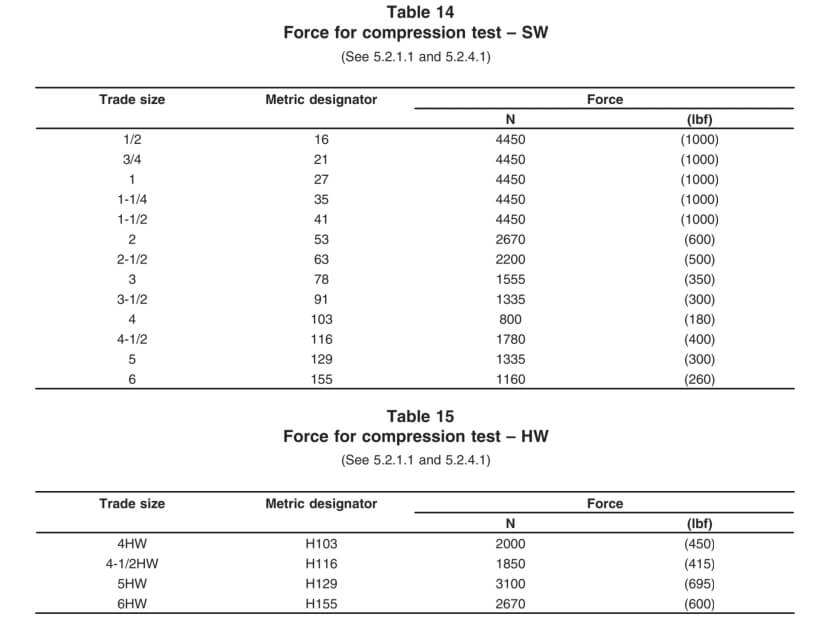
Each specimen is tested for post-flame duration: flaming should not exceed 30 seconds after the first four flame applications, nor 60 seconds after the fifth.
The optional FT4 flame test is one of the most rigorous, required in certain Canadian noncombustible building constructions. It involves exposure to a 70 000 BTU/heure flame for 20 minutes.
Pass criteria: Charred length must not exceed 1.5 m (5 ft.) from the bottom of the burner (CSA C22.2 No.38).
Qualification Tests for Reinforced Thermosetting Resin Conduit (RTRC)
3. Exploring Burial Depth Requirements for Rigid Electrical Conduits
Dans le domaine des installations électriques, la profondeur d'enfouissement appropriée des conduits est primordiale pour garantir la sécurité, la conformité et la durabilité. Les conduits électriques rigides, y compris les conduits métalliques rigides (RMC), les conduits non métalliques comme le PVC et les conduits en fibre de verre, ont des exigences de profondeur d'enfouissement spécifiques dictées à la fois par le National Electrical Code (NEC) et les codes du bâtiment locaux.
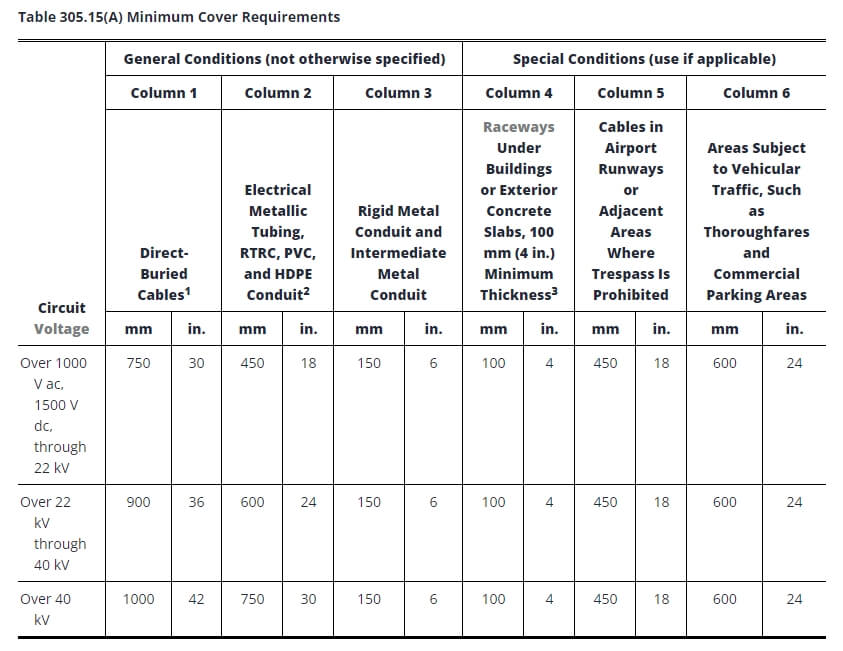
Remarques :
1. Cover shall be defined as the shortest distance in millimeters (inches) measured between a point on the top surface of any direct-buried conductor, cable, conduit, or other raceway and the top surface of finished grade, concrete, or similar cover.
2. Lesser depths shall be permitted where cables and conductors rise for terminations or splices or where access is otherwise required.
3. Where solid rock prevents compliance with the cover depths specified in this table, the wiring shall be installed in a metal or nonmetallic raceway permitted for direct burial. The raceways shall be covered by a minimum of 50 mm (2 in.) of concrete extending down to rock.
4. In industrial establishments, where conditions of maintenance and supervision ensure that qualified persons will service the installation, the minimum cover requirements for other than rigid metal conduit and intermediate metal conduit shall be permitted to be reduced 150 mm (6 in.) for each 50 mm (2 in.) of concrete or equivalent placed entirely within the trench over the underground installation.
5. Direct Buried Cables: Underground direct-buried cables that are not encased or protected by concrete and are buried 750 mm (30 in.) or more below grade shall have their location identified by a warning ribbon that is placed in the trench at least 300 mm (12 in.) above the cables.
6. Electrical Metallic Tubing, RTRC, PVC, and HDPE Conduit: These may be listed by a qualified testing agency as suitable for direct burial without encasement. All other nonmetallic systems shall require 50 mm (2 in.) of concrete or equivalent above the conduit in addition to the table depth.
7. Raceways Under Buildings or Exterior Concrete Slabs (100 mm / 4 in. Minimum Thickness): The slab shall extend a minimum of 150 mm (6 in.) beyond the underground installation, and a warning ribbon or other effective means suitable for the conditions shall be placed above the underground installation.
8. Other nonshielded cables not covered in 305.15(A)(1) or (A)(2) shall be installed in rigid metal conduit, intermediate metal conduit, or rigid nonmetallic conduit encased in not less than 75 mm (3 in.) of concrete.
9. Conductors Emerging from the Ground: These shall be enclosed in listed raceways. Raceways installed on poles shall be of rigid metal conduit, intermediate metal conduit, RTRC-XW, Schedule 80 PVC conduit, or equivalent, extending from the minimum cover depth specified in Table 305.15(A) to a point 2.5 m (8 ft) above finished grade.
Les facteurs environnementaux influencent considérablement la profondeur d'enfouissement des conduits. Les conditions du sol, telles que la stabilité et la teneur en humidité, peuvent déterminer la profondeur à laquelle un conduit doit être installé pour garantir sa sécurité au fil du temps. Par exemple, dans les sols rocheux ou instables, un enfouissement plus profond peut être nécessaire pour éviter les dommages causés par les mouvements du sol.
Les charges de trafic jouent également un rôle essentiel, notamment dans les zones où les conduits sont installés sous les routes ou les parkings. Dans ce cas, un enfouissement plus profond est souvent nécessaire pour protéger les conduits du poids et des vibrations des véhicules et des équipements lourds.
4. Installation Guidelines for Different Types of Rigid Conduit
Before starting, gather the following tools and materials:
• Cutting tools: Hacksaw or roll cutter (if cutting is required).
• Reamer: To remove burrs inside the conduit after cutting.
• Conduit bender: For making precise bends.
• Wrenches: Appropriately sized.
• Thread-sealing compound or corrosion-resistant paint: To protect threads if necessary.
Also confirm you have all necessary fittings, couplings, and connectors to ensure proper grounding.
• Measure and Cut: Measure required length and cut cleanly with a saw.
• Ream: Remove burrs inside the conduit to avoid wire damage.
• Threading: Use a standard ¾-inch per foot (NPT) die for threading if needed. Threads should be smooth and clean.
For pre-threaded conduit, skip threading but protect exposed or damaged threads.
• Hand-Tighten and Wrench Finish: Start hand-tightening, then wrench-tighten typically one full turn beyond hand-tight.
• Avoid Over-Tightening: Excessive force can damage threads and coating. Do not use wrench extensions.
• For threadless fittings, push conduit fully into fitting and secure with appropriate torque.
• Hand Bending: Small sizes (½ to 1 inch) can be bent with a hand bender; larger sizes require mechanical or power benders.
• Precision: Mark bends; avoid exceeding 90° between pulling points.
• Avoid Kinks: Prevent flattening or kinking, which reduces space and complicates wire pulling.
• For pre-threaded conduit, avoid damaging threads during bending.
• Use straps, hangers, or clamps to secure conduits to walls, ceilings, or structural members.
• For vertical runs, secure conduit at the top end to prevent sagging.
• For conduits transitioning from concrete to soil or underground, apply approved coatings, wraps, or PVC-coated conduit for extra protection.
• Inspect factory-applied coatings for damage during installation.
• Apply corrosion-resistant compounds, zinc-rich paint, or corrosion-resistant tape as needed.
• Protect field-cut threads with corrosion-resistant, electrically conductive coatings.
• Perform continuity testing to confirm electrical continuity and grounding.
• Inspect all conduit connections for tightness and secure supports.
• Verify protective coatings remain intact and additional protections are applied as necessary.
Avant de commencer, rassemblez les outils et matériaux nécessaires pour une installation réussie de conduits en PVC :
Conduit en PVC : le diamètre et la longueur appropriés pour votre projet.
Raccords en PVC : raccords, coudes, boîtes de jonction et autres composants.
Ciment et apprêt PVC : Pour fixer les joints et les raccords.
Coupe-conduit ou scie à métaux : pour couper le conduit à la longueur requise.
Outil d'ébavurage : pour lisser les bords coupés du conduit.
Ruban à mesurer : pour des mesures précises.
Niveau : Pour assurer un alignement correct.
Tire-fil ou ruban de tirage : pour tirer les fils à travers le conduit après l'installation.
Avant de commencer l'installation, planifiez soigneusement le parcours de votre conduit en PVC. Cela comprend la mesure de la distance entre les points où le conduit passera et le repérage des endroits où les coudes, les raccords et les jonctions seront nécessaires.
Mesurer et marquer : utilisez un ruban à mesurer pour déterminer la longueur du conduit en PVC requise pour chaque section et marquez les endroits où les coupes seront effectuées.
Tenez compte de la dilatation et de la contraction : les conduits en PVC se dilatent et se contractent en fonction des changements de température. Vous devrez donc laisser un peu de place pour le mouvement ou installer des raccords de dilatation sur les longues distances.
Couper des conduits en PVC est beaucoup plus facile que couper des conduits métalliques, mais il est toujours important de faire des coupes nettes et précises pour assurer une installation en douceur.
Couper le conduit : Utilisez un coupe-conduit en PVC ou une scie à métaux à dents fines pour couper le conduit aux longueurs mesurées. Assurez-vous que les coupes sont droites et nettes.
Ébavurage des bords : après la coupe, utilisez un outil d'ébavurage ou un couteau utilitaire pour éliminer les bords rugueux ou les bavures à l'intérieur et à l'extérieur du conduit. Cette étape est essentielle pour éviter d'endommager les fils lorsqu'ils sont tirés à travers le conduit.
Contrairement aux conduits métalliques, pour lesquels des filetages ou des raccords à vis sont utilisés, les sections de conduits en PVC sont assemblées par un procédé appelé soudage par solvant. Cela implique l'utilisation d'un apprêt et d'un ciment PVC pour coller le conduit et les raccords ensemble.
Appliquer l'apprêt : Tout d'abord, nettoyez les extrémités du conduit et l'intérieur des raccords à l'aide d'un apprêt PVC. L'apprêt ramollit le matériau et le prépare au processus de collage.
Appliquer le ciment PVC : Immédiatement après avoir appliqué l'apprêt, recouvrir les mêmes zones avec du ciment PVC. Veillez à travailler rapidement, car le ciment sèche rapidement.
Assemblez le conduit et les raccords : poussez le conduit dans le raccord, en le tournant légèrement pour assurer une répartition uniforme du ciment. Maintenez les pièces ensemble pendant quelques secondes pour assurer une liaison solide.
Essuyez l'excès de ciment : retirez tout excès de ciment qui s'échappe pendant le processus de connexion. Laissez le joint durcir conformément aux instructions du fabricant avant de le manipuler davantage.
Ce procédé de soudage par solvant crée un joint étanche, ce qui rend le PVC idéal pour les installations extérieures et souterraines où la résistance à l'humidité est essentielle.
Le cintrage des conduits en PVC est différent du cintrage des conduits métalliques. Le PVC peut être plié à chaud pour créer des courbes lisses et personnalisées sans avoir recours à des coudes préfabriqués dans certaines situations.
Chauffer le conduit en PVC : utilisez un pistolet thermique ou un appareil de cintrage en PVC pour chauffer la section du conduit où le cintrage est nécessaire. Veillez à appliquer la chaleur uniformément pour éviter de déformer le conduit.
Faire le coude : Une fois le conduit flexible, pliez-le lentement jusqu'à l'angle souhaité. Maintenez-le en place jusqu'à ce que le conduit refroidisse et conserve sa forme.
Utilisez des coudes préfabriqués : pour la plupart des installations, il est plus facile d'utiliser des coudes en PVC à 90 ou 45 degrés fabriqués en usine, qui sont collés en place à l'aide du même processus de soudage par solvant.
Étant donné que le PVC est plus flexible et léger que les conduits métalliques, il nécessite un support approprié pour éviter tout affaissement ou mouvement au fil du temps.
Installer des colliers ou des pinces pour conduits : soutenez le conduit en PVC à intervalles réguliers en le fixant avec des colliers ou des pinces pour conduits. Suivez les directives du NEC, qui recommandent de soutenir le PVC tous les 3 à 6 pieds, selon le diamètre du conduit.
Permettre la dilatation : les conduits en PVC se dilatent et se contractent en fonction des variations de température. Sur les longueurs plus longues, installez des raccords de dilatation pour permettre le mouvement sans solliciter les joints. Les raccords de dilatation sont essentiels pour les installations extérieures ou exposées au soleil où les fluctuations de température sont importantes.
Une fois le conduit installé et les joints de ciment durcis, vous pouvez tirer les fils à travers le conduit.
Utilisez un ruban de tirage ou une ficelle de tirage : faites passer le ruban de tirage ou la ficelle de tirage dans le conduit, puis fixez solidement les fils au ruban.
Tirez les fils : tirez lentement les fils à travers le conduit, en vous assurant qu'ils ne s'accrochent pas ou ne sont pas endommagés sur les bords rugueux.
Lubrifier si nécessaire : si le conduit est long ou comporte plusieurs coudes, utilisez un lubrifiant de tirage de fil pour réduire la friction et faciliter le processus de tirage de fil.
Une fois les fils tirés et le système installé, effectuez une inspection finale pour vous assurer que tout est installé correctement et en toute sécurité.
Vérifiez les connexions : assurez-vous que tous les joints soudés au solvant sont solides et qu'aucun raccord n'est desserré.
Vérifier les supports : Confirmez que toutes les sangles et pinces de conduit sont correctement espacées et fixées.
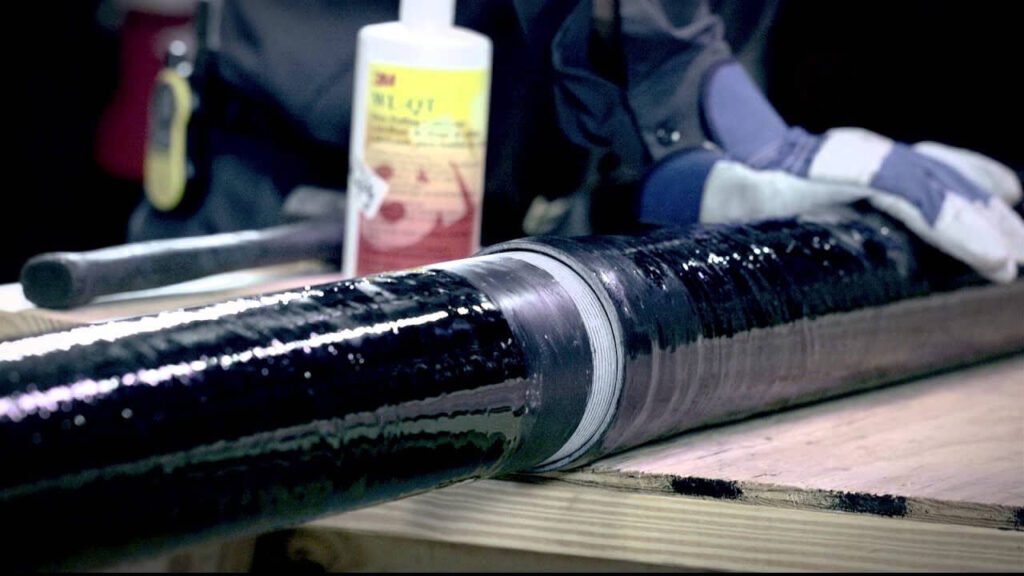
Pour une installation réussie des conduits RTRC, rassemblez les outils et matériaux suivants :
- RTRC Conduit: Appropriate diameter and lengths of conduit.
- RTRC Fittings: Couplings, elbows, and other necessary components.
- Two-Part Epoxy or Adhesive: To bond conduit sections and fittings.
- Hacksaw or Fine-Toothed Saw: For cutting the conduit to size.
- Deburring Tool or Sandpaper: To smooth cut edges.
- Measuring Tape and Level: For precise measurements and alignment.
- Pull String or Fish Tape: To pull wires through the conduit after installation.
- Heat Gun: For heat-shrink components if needed.
Comme pour tout système de conduits, commencez par planifier l'itinéraire et la disposition de l'installation du RTRC. Identifiez les points où les conduits changeront de direction, où les raccords seront nécessaires et où les points d'accès ou les boîtes de jonction doivent être placés.
Measure and Mark: Use a tape measure to accurately determine the lengths of conduit required and mark where cuts will need to be made.
La coupe du conduit RTRC est similaire à la coupe du PVC, mais la composition du matériau nécessite une manipulation soigneuse pour éviter d'endommager les fibres.
Cut the Conduit: Use a hacksaw, reciprocating saw, or any fine-toothed saw to cut the conduit to the desired length. Make sure the cut is straight to allow for proper joining.
Deburr the Edges: After cutting, smooth the inside and outside edges using a deburring tool or sandpaper. This prevents damage to wire insulation.
Dust Control: When cutting RTRC, use PPE such as gloves, eye protection, and a dust mask or respirator to manage fiberglass dust.
RTRC conduit is joined using adhesives or a two-part epoxy designed for fiberglass conduit systems.
Prepare the Surfaces: Clean conduit ends and fitting interiors to remove dust, dirt, and oil.
Apply the Adhesive: Use the recommended epoxy. Apply generously to both joining surfaces.
Join and Set: Insert and twist the conduit into the fitting. Hold briefly until set begins.
Curing Time: Allow full curing as per manufacturer guidelines before applying load or stress.
RTRC conduit needs adequate support, especially in horizontal applications:
- Use approved straps, hangers, or clamps every 6–10 feet per NEC requirements.
- Expansion Joints: Include expansion fittings in long runs or areas with temperature swings.
Bending RTRC conduit is typically not done on site:
- Use factory-made elbows and bends (e.g., 90°, 45°), joined with adhesive.
- No Heat Bending: Heating damages RTRC’s structural integrity.
Once adhesive is cured, proceed to wire installation:
- Use fish tape or pull string to guide wires through conduit.
- Apply lubricant on long or complex runs to ease pulling.
- Ensure NEC-compliant grounding and bonding, as RTRC is non-conductive.
Before energizing the system:
- Inspect all adhesive joints to confirm secure bonding.
- Verify that all supports are in place and at correct intervals.
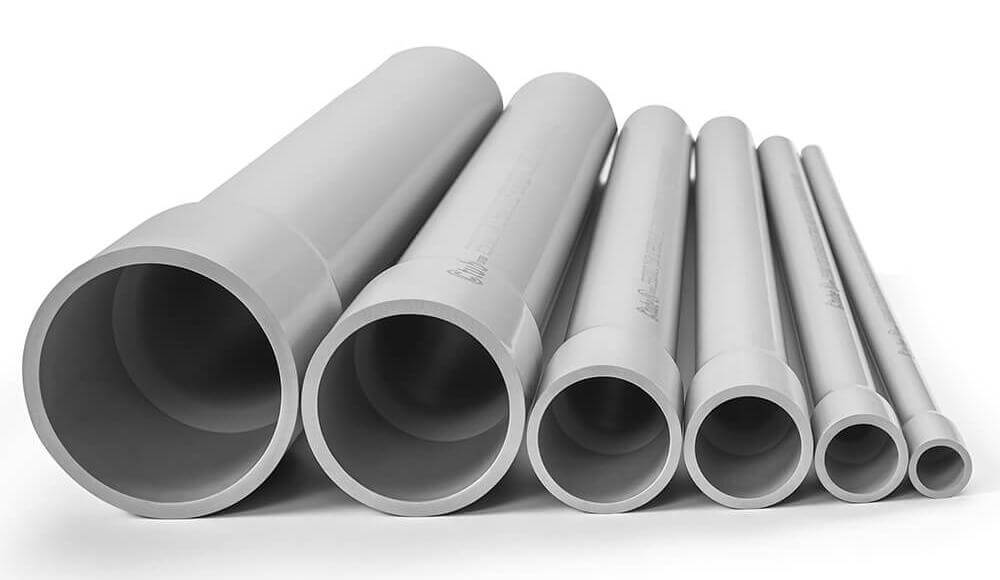
5. Conclusion
| Caractéristiques | RMC | CMI | EMT | PVC | RTRC |
|---|---|---|---|---|---|
| Coût | Coût initial le plus élevé | Coût modéré | Inférieur à RMC et IMC | Coût initial le plus bas | Coût modéré à élevé |
| Durabilité | Très durable, très résistant | Durable, mais plus léger que le RMC | Moins durable que le RMC et l'IMC | Durable, mais pas aussi solide que le métal | Très durable, résistant aux chocs |
| Résistance à la corrosion | Bon avec les revêtements | Better with coatings | Sujet à la corrosion à moins d'être revêtu | Excellent, naturellement résistant | Excellent, très résistant |
| Facilité d'installation | Lourd, nécessite plus de travail | Modéré, plus léger que le RMC | Le plus simple à installer | Facile, léger et flexible | Facile à installer, léger |
Importance of Selecting the Right Conduit for Different Environments
Pour les applications hors sol, privilégiez les options résistantes aux UV pour résister aux rayons du soleil, tandis que pour les installations souterraines, concentrez-vous sur la résistance à l'humidité et à la corrosion pour vous protéger contre les facteurs environnementaux.
Moisture-Prone Areas
In environments where moisture is prevalent—such as basements, bathrooms, or outdoor installations—choosing conduits with water resistance is vital.
Options like PVC or specialized moisture-resistant conduits help prevent corrosion, which can lead to electrical failures and safety hazards.
Additionally, moisture-resistant conduits often meet specific codes for wet locations, ensuring compliance with electrical standards.
Corrosion Risks
In industrial or commercial settings, conduits may be exposed to various chemicals, including solvents, acids, or caustics.
Using conduits made from materials that resist chemical degradation—such as certain types of PVC or metal conduits—helps maintain the integrity of the wiring.
This selection not only prevents damage to the conduit itself but also safeguards the surrounding environment and personnel from hazardous exposure.
In coastal areas or places with high humidity, selecting corrosion-resistant conduits is essential.
Options like fiberglass or stainless steel conduits can withstand harsh environmental conditions, preventing premature deterioration and ensuring long-term reliability.
This choice is particularly important for underground or submerged installations, where exposure to moisture and salts is unavoidable.
Extreme Temperatures
Regions that experience extreme temperatures, whether hot or cold, require conduits designed to withstand such conditions.
For instance, conduits that are rated for high heat or freeze resistance ensure that the wiring remains functional without compromising safety.
In extreme cold, flexible conduits may be necessary to prevent cracking, while in high heat, UV-resistant materials can protect against sun exposure.
En examinant attentivement ces facteurs, vous pouvez faire un choix éclairé qui répond à la fois aux besoins de performance et aux normes réglementaires, contribuant ainsi au succès de votre projet.
Ctube is a premier manufacturer of high-quality PVC conduit solutions, dedicated to delivering reliable and durable products for electrical installations.
Based in China, we specialize in producing a wide range of conduits designed to meet the diverse needs of various industries, all while ensuring compliance with international standards.
Our PVC rigid conduit adheres to rigorous certifications such as UL 651, AS/NZS 2053, and CSA, guaranteeing exceptional performance, durability, and safety across different regions.
Thank you for reading! We hope this post was helpful to your project. Wishing you success in all your work — and feel free to reach out to us if you have any project needs or inquiries.
FAQ
1. Quelle est la différence entre un conduit rigide et un conduit flexible ?
Le conduit rigide offre une meilleure protection grâce à sa structure solide, ce qui le rend idéal pour les environnements soumis à de fortes contraintes mécaniques ou à une exposition à l'humidité et aux produits chimiques.
Le conduit flexible est plus facile à installer et permet le mouvement, ce qui le rend plus adapté aux zones où la flexibilité est nécessaire.
2. Comment le conduit rigide est-il fixé pendant l'installation ?
Les conduits rigides sont fixés à l'aide de différents types de fixations, telles que des colliers, des supports et des sangles, en fonction de l'environnement d'installation (intérieur, extérieur ou souterrain). Ces fixations garantissent que le conduit reste fermement en place et protègent le câblage à l'intérieur.
3. Comment tourner un coin avec un conduit électrique rigide ?
Les raccords de conduits jouent un rôle crucial pour assurer des virages en douceur pour les systèmes de conduits rigides. Les raccords courants comprennent les coudes et les coudes à balayage, conçus pour créer des virages à 90 degrés ou en angle tels que des angles de 45 degrés et de 22,5 degrés. Les connecteurs en T sont également fréquemment utilisés pour permettre aux conduits de se ramifier dans différentes directions.
Parmi les conduits rigides, les tubes métalliques électriques (EMT) sont les plus faciles à cintrer. Des outils comme un ressort ou une cintreuse de conduits sont essentiels pour réaliser des coudes précis, garantissant un alignement et une installation corrects.


